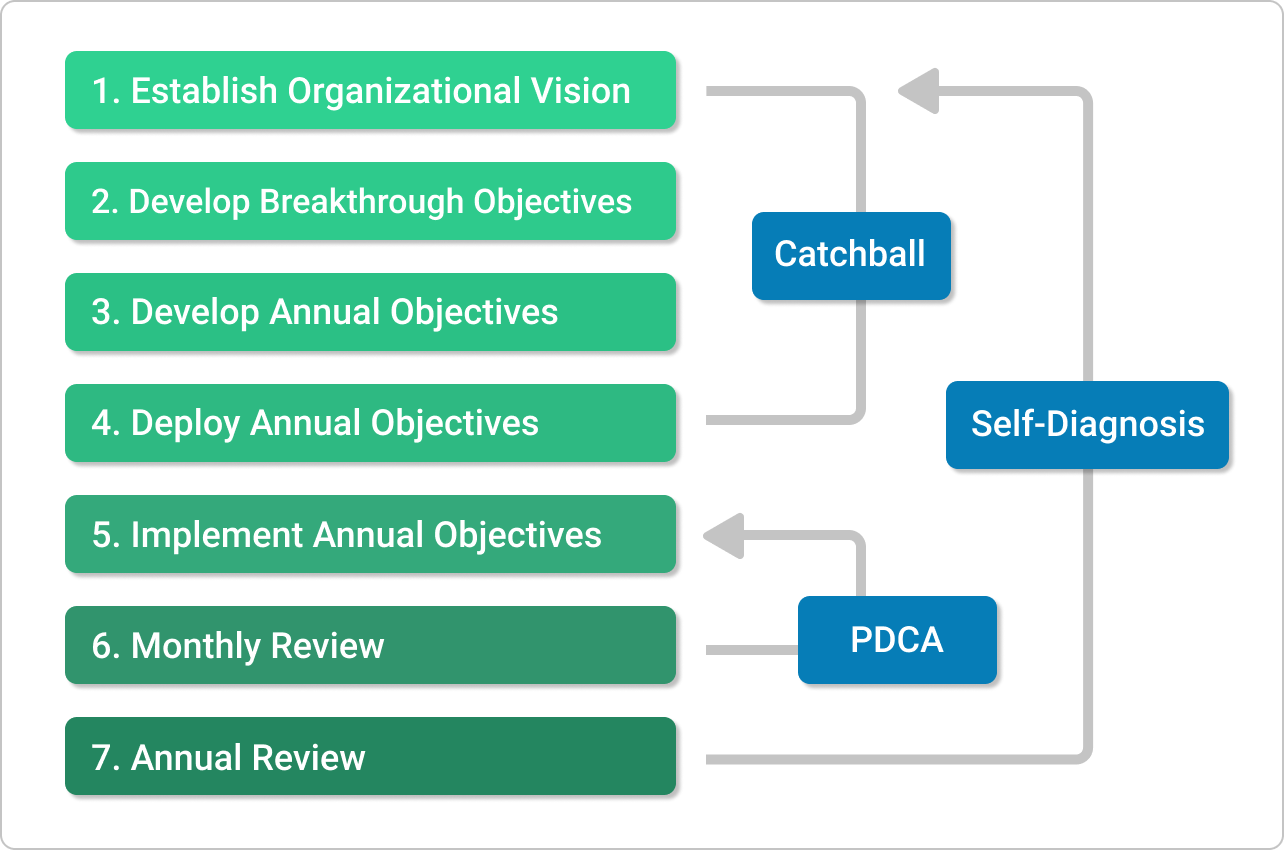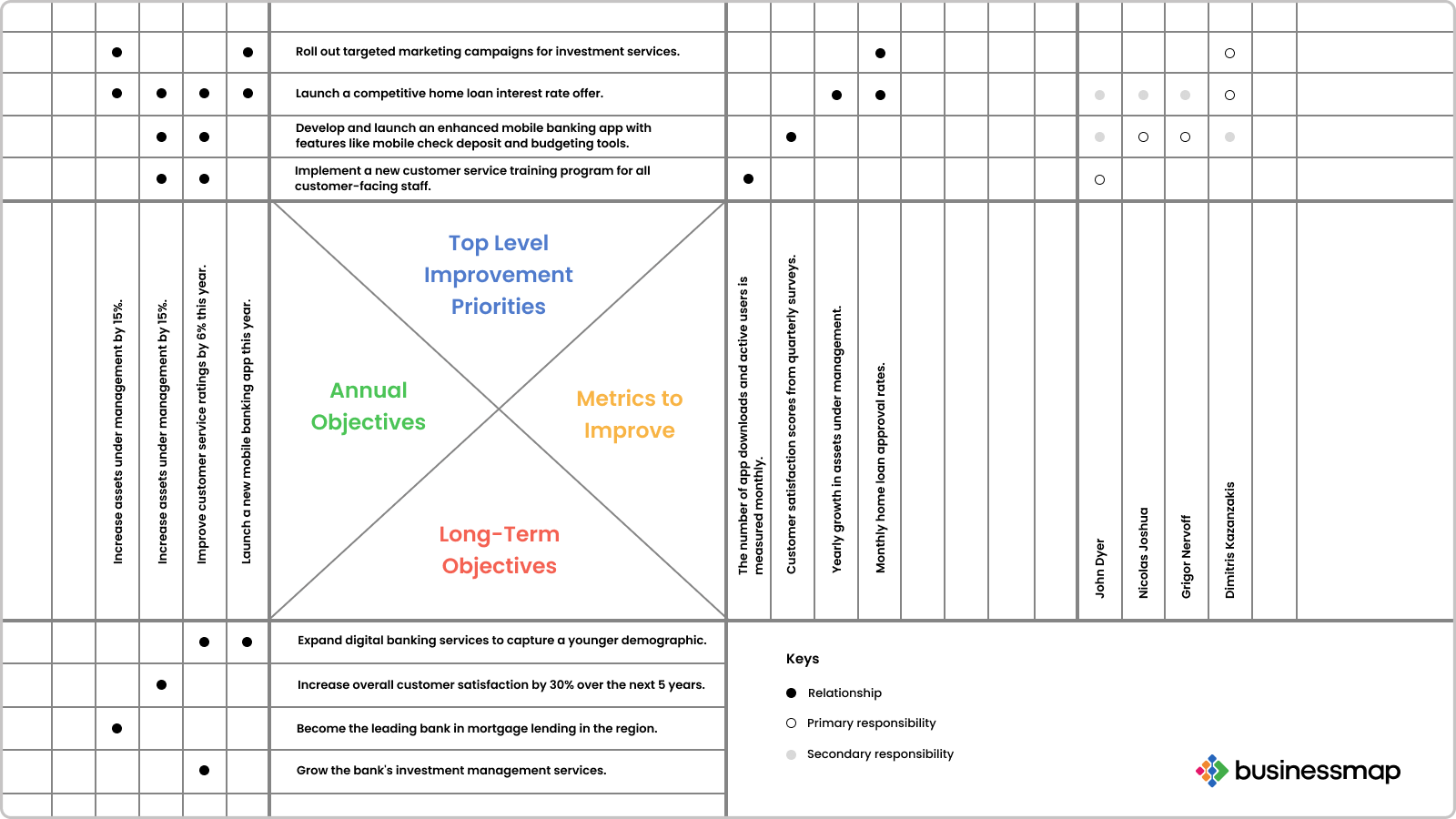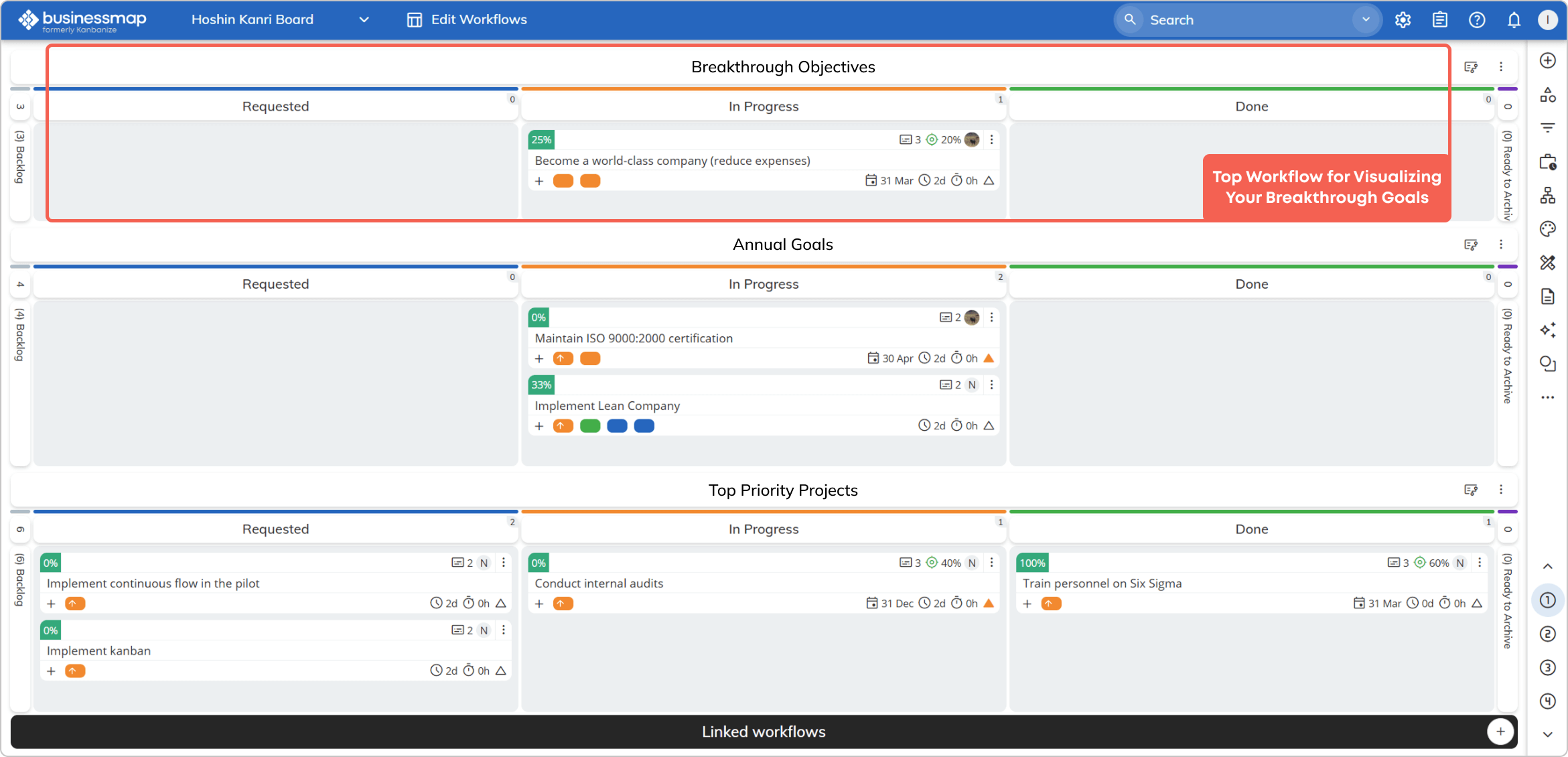Key Takeaways
-
What is Hoshin Kanri? Hoshin Kanri is a Lean approach for aligning strategy with execution across all levels of an organization.
-
How Hoshin planning works: It uses a 7-step process to plan, deploy, execute, and review.
-
Supporting systems: Catchball and PDCA create feedback loops and support continuous improvement.
-
How to implement Hoshin Kanri: Tools like the X-Matrix help with planning; Portfolio Kanban helps with execution.
What Is Hoshin Kanri?
Hoshin Kanri (also called Hoshin Planning) translates roughly to "direction management." It's a Lean management approach focused on aligning a company's strategic goals with its daily operations - top to bottom.
The words "hoshin" and "kanri" mean "direction" and "management" respectively. Used together, they bring the meaning of "How do we manage our direction" or "How do we make sure we go the right way?"
How Is Hoshin Planning Different from Traditional Planning?
Unlike traditional planning, which often stays siloed at the leadership level, Hoshin Kanri ensures that strategy is deployed across every layer of the business. It turns vision into execution.
Think of it this way: Traditional planning sets the destination. Hoshin Kanri maps the roads and traffic signals to get there.
What Are the 7 Steps of Hoshin Kanri?
The Hoshin Planning process ensures that the strategy is executed effectively across the organization. It's structured around 7 core steps:
-
Define the Vision: Why does your company exist? What is its long-term purpose?
-
Set Breakthrough Objectives: These are primary goals that demand everyone's involvement. They're not quick wins but long-term, high-impact efforts.
-
Establish Annual Goals: Break those breakthrough goals into annual targets that are ambitious but realistic.
-
Deploy Goals Across the Org: This is where the cascade begins. Goals move from the top down - but with feedback loops.
-
Execute the Plan: Teams begin work toward the goals, often aligning through joint planning and prioritization.
-
Monthly Reviews: Frequent check-ins ensure progress stays on track.
-
Annual Review: Assess what's been achieved and identify what needs to evolve for the next cycle.
This planning structure enables organizations to focus, align with the strategy, and act without losing sight of the bigger picture.

How Do You Involve Your Team in Hoshin Kanri?
Catchball
Unlike traditional top-down planning, Hoshin Kanri promotes shared ownership through a practice known as Catchball.
Here's how it works: instead of pushing goals down the chain of command, leaders toss them like a ball to their teams, who catch them, shape them, and toss them back. This exchange continues until goals are realistic, well-understood, and actionable.
If management dictates goals without input, it can lead to confusion, disengagement, or even failure. But when people co-create the goals, they take ownership. They're more motivated and far less likely to be caught off guard by on-the-ground challenges.
Helpful Tip: Use Catchball to build trust. It's not about consensus - it's about clarity and commitment.
PDCA
Another foundational element of Hoshin Kanri is the PDCA cycle (Plan-Do-Check-Act). Originally introduced by W. Edwards Deming, PDCA is a systematic method for driving continuous improvement. In the context of Hoshin Planning, it ensures that execution isn’t a one-time effort - it’s a repeating loop of testing, learning, and adapting.
- Plan: Define the experiment and set expectations.
- Do: Carry out the plan on a small scale.
- Check: Analyze results and compare them with expectations.
- Act: Standardize the improvement if successful - or pivot and restart the loop.
Used regularly, PDCA builds learning into your execution process, helping teams stay agile and outcomes-focused.
What Tools Help Execute Hoshin Kanri?
Most companies get introduced to Hoshin Planning through the X-Matrix - a visual tool for connecting strategy, tactics, and accountability. It helps you link breakthrough goals with annual objectives, projects, and responsible parties.
 Visualizing breakthrough goals with annual objectives, metrics, and responsible parties using a Hoshin Kanri X matrix
Visualizing breakthrough goals with annual objectives, metrics, and responsible parties using a Hoshin Kanri X matrix
But planning isn't enough. Execution is where most strategies fail. That's where the Portfolio Kanban concept becomes essential.
Portfolio Kanban enables you to map Hoshin goals onto visual boards and track them in real time. When the CEO and leadership team define the vision, they work with program managers to identify programs that will fulfill those goals. From there, projects are defined, tasks are assigned, and execution flows down to every level.
This visual structure ensures no objective is lost in translation - and progress can be tracked without constant status meetings.
Hoshin planning digital platforms like Businessmap enhances this process. It integrates Hoshin Kanri with real-time data, reduces reporting friction, and supports predictive analytics through Monte Carlo simulations.
 Visualizing breakthrough objectives, annual goals, priority projects and involved teams' workflows on a portfolio board in Businessmap
Visualizing breakthrough objectives, annual goals, priority projects and involved teams' workflows on a portfolio board in Businessmap
Bonus Move: Automate monthly reviews and gain forecasting insights that let you course-correct before it's too late.
What Challenges and Best Practices Should You Know?
Let's be real - setting annual goals in today's fast-moving world can feel outdated. Markets shift. Teams pivot. And a 12-month strategy can become irrelevant halfway through the year.
That's why traditional Hoshin Kanri must be adapted. Yes, breakthrough goals and long-term vision matter - but agility is the name of the game.
✔ Review goals monthly, not just annually
✔ Use real-time dashboards to keep execution visible
✔ Align through shorter feedback loops and adaptive planning
One of the biggest risks? Pursuing local optimums - goals that work well in isolation but damage the bigger system. That's why PDCA is crucial.
Extra Visibility Move: Always aim for the system optimum. It's not about making one team fast - it's about making the whole business flow.
Why Lean Organizations Use Hoshin Kanri
There's never been more noise in the business world. Anyone can launch a product. But getting people to care - and scaling that into sustainable impact? That's the real challenge.
Hoshin Kanri gives Lean organizations a system for doing both. It forces leadership to define meaningful goals. It ensures teams understand their role in achieving them. And it creates alignment and momentum from the top down - and bottom up.
For enterprise companies, it's a lifeline to clarity. For fast-growing teams, it's the structure that keeps chaos at bay.
In Lean language, Hoshin Kanri eliminates strategic waste by ensuring every effort contributes to the bigger picture.
Businessmap is the most flexible software
to align work with company goals






 Visualizing breakthrough goals with annual objectives, metrics, and responsible parties using a Hoshin Kanri X matrix
Visualizing breakthrough goals with annual objectives, metrics, and responsible parties using a Hoshin Kanri X matrix Visualizing breakthrough objectives, annual goals, priority projects and involved teams' workflows on a portfolio board in Businessmap
Visualizing breakthrough objectives, annual goals, priority projects and involved teams' workflows on a portfolio board in Businessmap


